Long-Term Contamination of the Arabian Gulf as a Result of Hypothetical Nuclear Power Plant Accidents
Abstract
:1. Introduction
2. Materials and Methods
2.1. Atmospheric Dispersion Model RIMPUFF
2.2. Source Terms for Atmospheric Releases from Bushehr and Barakah NPPs
2.3. Marine Compartment Model POSEIDON-R
2.4. Poseidon-R Model Setup
2.5. Scenarios of Atmospheric Deposition
3. Results
3.1. Bushehr NPP
3.2. Barakah NPP
3.3. Doses for Humans
4. Discussion and Summary
Supplementary Materials
Author Contributions
Funding
Institutional Review Board Statement
Informed Consent Statement
Data Availability Statement
Acknowledgments
Conflicts of Interest
References
- Le Quesne, W.J.F.; Fernand, L.; Ali, T.S.; Andres, O.; Antonpoulou, M.; Burt, J.A.; Dougherty, W.W.; Edson, P.J.; El Kharraz, J.; Glavan, J.; et al. Is the development of desalination compatible with sustainable development of the Arabian Gulf? Mar. Pollut. Bull. 2021, 173, 112940. [Google Scholar] [CrossRef]
- World Nuclear Association. Plans For New Reactors Worldwide. Available online: https://world-nuclear.org/information-library/current-and-future-generation/plans-for-new-reactors-worldwide.aspx (accessed on 18 January 2023).
- Terada, H.; Katata, G.; Chino, M.; Nagai, H. Atmospheric discharge and dispersion of radionuclides during the Fukushima Dai-ichi Nuclear Power Plant accident. Part II: Verification of the source term and analysis of regional-scale atmospheric dispersion. J. Environ. Radioact. 2012, 112, 141–154. [Google Scholar] [CrossRef] [PubMed]
- Dvorzhak, A.; Puras, C.; Montero, M.; Mora, J.C. Spanish experience on modeling of environmental radioactive contamination due to Fukushima Daiichi NPP accident using JRODOS. Environ. Sci. Technol. 2012, 46, 11887–11895. [Google Scholar] [CrossRef] [PubMed]
- Evangeliou, N.; Balkanski, Y.; Cozic, A.; Møller, A.P. Simulations of the transport and deposition of 137Cs over Europe after the Chernobyl Nuclear Power Plant accident: Influence of varying emission-altitude and model horizontal and vertical resolution. Atmos. Chem. Phys. 2013, 13, 7183–7198. [Google Scholar] [CrossRef]
- Bezhenar, R.; Kovalets, I. Modeling of radioactive contamination of the Black Sea and its impact on humans due to hypothetical heavy accident at the Zaporizhzhia NPP. In Mathematical Modeling and Simulation of Systems. MODS 2022. Lecture Notes in Networks and Systems; Shkarlet, S., Morozov, A., Palagin, A., Vinnikov, D., Stoianov, N., Zhelezniak, M., Kazymyr, V., Eds.; Springer: Cham, Switzerland, 2023. [Google Scholar]
- Periáñez, R.; Bezhenar, R.; Brovchenko, I.; Duffa, C.; Iosjpe, M.; Jung, K.T.; Kim, K.O.; Kobayashi, T.; Liptak, L.; Little, A.; et al. Marine radionuclide transport modelling: Recent developments, problems and challenges. Environ. Model. Softw. 2019, 122, 104523. [Google Scholar] [CrossRef]
- Tsabaris, C.; Tsiaras, K.; Eleftheriou, G.; Triantafylou, G. 137Cs ocean distribution and fate at East Mediterranean Sea in case of a nuclear accident in Akkuyu Nuclear Power Plant. Prog. Nucl. Energy 2021, 139, 103879. [Google Scholar] [CrossRef]
- Periáñez, R. APERTRACK: A particle-tracking model to simulate radionuclide transport in the Arabian/Persian Gulf. Prog. Nucl. Energy 2021, 142, 103998. [Google Scholar] [CrossRef]
- Periáñez, R.; Cortés, C. A Numerical model to simulate the transport of radionuclides in the Western Mediterranean after a nuclear accident. J. Mar. Sci. Eng. 2023, 11, 169. [Google Scholar] [CrossRef]
- Brovchenko, I.; Kim, K.O.; Maderich, V.; Jung, K.T.; Bezhenar, R.; Ryu, J.H.; Min, J.E. Sediment and radioactivity transport in the Bohai, Yellow, and East China Seas: A modeling study. J. Mar. Sci. Eng. 2022, 10, 596. [Google Scholar] [CrossRef]
- Li, Z.; Zhou, T.; Zhang, B.; Si, G.; Ali, M. Research on radionuclide migration in coastal waters under nuclear leakage accident. Prog. Nucl. Energy 2020, 118, 103114. [Google Scholar] [CrossRef]
- Yu, P.K.N. Trans-oceanic transport of 137Cs from the Fukushima nuclear accident and impact of hypothetical Fukushima-like events of future nuclear plants in Southern China. Sci. Total Environ. 2015, 508, 128–135. [Google Scholar] [CrossRef]
- IAEA. Generic Models for Use in Assessing the Impact of Discharges of Radioactive Substances to the Environment; Safety Reports Series 19; International Atomic Energy: Vienna, Austria, 2001. [Google Scholar]
- Kamyab, A.; Azad, M.T.; Sadeghi, M.; Akhound, A. Dispersion simulation of cesium-137 released from a hypothetical accident at the Bushehr nuclear power plant in Persian Gulf. Int. J. Coast. Offshore Environ. Eng. 2018, 2, 13–17. [Google Scholar] [CrossRef]
- Hassanvand, M.; Mirnejad, Z. Hydrodynamic model of radionuclide dispersion during normal operation and accident of Bushehr nuclear power plant. Prog. Nucl. Energy 2019, 116, 115–123. [Google Scholar] [CrossRef]
- HYCOM. Available online: https://www.hycom.org/dataserver (accessed on 2 December 2022).
- Mikkelsen, T.; Thykier-Nielsen, S.; Hoe, S. Chapter 2.16 Medium-range puff growth. In Air Pollution Modeling and Its Application; Borrego, C., Renner, E., Eds.; XVIII, Developments in Environmental Science; Elsevier: Amsterdam, The Netherlands, 2007; Volume 6, pp. 243–252. [Google Scholar] [CrossRef]
- Bezhenar, R.; Heling, R.; Ievdin, I.; Iosjpe, M.; Maderich, V.; Willemsen, S.; de With, G.; Dvorzhak, A. Integration of marine food chain model POSEIDON in JRODOS and testing versus Fukushima data. Radioprotection 2016, 51, S137–S139. [Google Scholar] [CrossRef]
- JRODOS. Available online: https://resy5.iket.kit.edu/JRODOS (accessed on 30 November 2022).
- Zhuang, S.; Fang, S.; Dong, X. Local-Scale Atmospheric Dispersion Modelling of Radionuclides Following the Fukushima Daiichi Nuclear Accident Using SWIFT-RIMPUFF. In Proceedings of the 2022 29th International Conference on Nuclear Engineering, Virtual Online, 8–12 August 2022; Volume 15. V015T16A031. [Google Scholar] [CrossRef]
- Andronopoulos, S.; Davakis, E.; Bartzis, J.G.; Kovalets, I. RODOS meteorological pre-processor and atmospheric dispersion model DIPCOT: A model suite for radionuclides dispersion in complex terrain. Radioprotection 2010, 45, S77–S84. [Google Scholar] [CrossRef]
- Jafarikia, S.; Feghhi, S.A.H. Study of in-containment source term behavior for VVER-1000 under LOCA conditions using the IRBURN code system. Ann. Nucl. Energy 2018, 112, 17–29. [Google Scholar] [CrossRef]
- Energoatom. Additional Targeted Re-Evaluation of Safety of the Reactors of Zaporizhzhia NPP with Taking into Account Fukushima Lessons; National Atomic Energy Generating Company ‘Energoatom’: Kyiv, Ukraine, 2012. [Google Scholar]
- KEPCO. APR Design Control Document TIER 2. Chapter 15 Transient and Accident Analyses, Revision 3, Korea Electric Power Corporation & Korea Hydro & Nuclear Power Co., Ltd. 2018. Available online: https://www.nrc.gov/docs/ML1500/ML15006A042.pdf (accessed on 10 November 2022).
- Lepicard, S.; Heling, R.; Maderich, V. POSEIDON/RODOS model for radiological assessment of marine environment after accidental releases: Application to coastal areas of the Baltic, Black and North seas. J. Environ. Radioact. 2004, 72, 153–161. [Google Scholar] [CrossRef] [PubMed]
- Maderich, V.; Bezhenar, R.; Tateda, Y.; Aoyama, M.; Tsumune, D.; Jung, K.T.; de With, G. The POSEIDON-R compartment model for the prediction of transport and fate of radionuclides in the marine environment. MethodsX 2018, 5, 1251–1266. [Google Scholar] [CrossRef]
- Bezhenar, R.; Jung, K.T.; Maderich, V.; de With, G.; Willemsen, S.; Qiao, F. Transfer of radiocaesium from contaminated bottom sediments to marine organisms through benthic food chain in post-Fukushima and post-Chernobyl periods. Biogeoscience 2016, 13, 3021–3034. [Google Scholar] [CrossRef]
- IAEA (International Atomic Energy Agency). Sediment Distribution Coefficients and Concentration Factors for Biota in the Marine Environment; Technical Report Series No 422; IAEA: Vienna, Austria, 2004; 95p. [Google Scholar]
- Bezhenar, R.; Kim, K.O.; Maderich, V.; de With, G.; Jung, K.T. Multi-compartment kinetic-allometric (MCKA) model of radionuclide bioaccumulation in marine fish. Biogeosciences 2021, 18, 2591–2607. [Google Scholar] [CrossRef]
- Yankovich, T.; Beresford, N.; Wood, M.; Aono, T.; Anderson, P.; Barnett, C.L.; Bennett, P.; Brown, J.E.; Fesenko, S.; Fesenko, J.; et al. Wholebody to tissue-specific concentration ratios for use in biota dose assessments for animals. Radiat. Environ. Biophys. 2010, 49, 549–565. [Google Scholar] [CrossRef]
- Pouil, S.; Bustamante, P.; Warnau, M.; Metian, M. Overview of trace element trophic transfer in fish through the concept of assimilation efficiency. Mar. Ecol. Prog. Ser. 2018, 588, 243–254. [Google Scholar] [CrossRef]
- Periañez, R.; Bezhenar, R.; Iosjpe, M.; Maderich, V.; Nies, H.; Osvath, I.; Outola, I.; de With, G. A comparison of marine radionuclide dispersion models for the Baltic Sea in the frame of IAEA MODARIA program. J. Environ. Radioact. 2015, 139, 66–77. [Google Scholar] [CrossRef]
- CMEMS, Copernicus Marine Environment Monitoring Service. Available online: http://marine.copernicus.eu (accessed on 11 November 2022).
- Alosairi, Y.; Imberger, J.; Falconer, R.A. Mixing and flushing in the Persian Gulf (Arabian Gulf). J. Geophys. Res. 2010, 116, C03029. [Google Scholar] [CrossRef]
- Al-Ghadban, A.N. Assessment of suspended sediment in Kuwait bay using Landsat and spot images. Kuwait J. Sci. Eng. 2004, 31, 155–172. [Google Scholar]
- Al-Ghadban, A.N.; Abdali, F.; Massoud, M.S. Sedimentation rate and bioturbation in the Arabian Gulf. Environ. Int. 1998, 24, 23–31. [Google Scholar] [CrossRef]
- Skamarock, W.C.; Klemp, J.B.; Dudhia, J.; Gill, D.O.; Barker, D.; Duda, M.G.; Huang, X.Y.; Wang, W.; Powers, J.G. A Description of the Advanced Research WRF Version 3; (No. NCAR/TN-475+STR); University Corporation for Atmospheric Research: Boulder, CO, USA, 2008. [Google Scholar] [CrossRef]
- GFS. NCEP GDAS/FNL 0.25 Degree Global Tropospheric Analyses and Forecast Grids. Research Data Archive at the National Center for Atmospheric Research, Computational and Information Systems Laboratory. National Centers for Environmental Prediction/National Weather Service/NOAA/U.S. Department of Commerce. 2015. Available online: https://rda.ucar.edu/datasets/ds083.3/ (accessed on 2 December 2022).
- Wolfram Research, WeatherData, Wolfram Language Function. 2008. Available online: https://reference.wolfram.com/language/ref/WeatherData.html (accessed on 2 December 2022). (updated 2014).
- Mahmoud, M.T.; Al-Zahrani, M.A.; Sharif, H.O. Assessment of global precipitation measurement satellite products over Saudi Arabia. J. Hydrol. 2018, 559, 1–12. [Google Scholar] [CrossRef]
- Uddin, S.; Fowler, S.; Behbehani, M.; Al-Ghadban, A.; Swarzenski, P.; Al-Awadhi, N. A review of radioactivity in the Gulf region. Mar. Pollut. Bull. 2020, 159, 111481. [Google Scholar] [CrossRef]
- ICRP (International Commission on Radiological Protection). Corrigenda to ICRP Publication 119: Compendium of Dose Coefficients based on ICRP Publication 60. Ann. ICRP 2013, 42, 1–130. [Google Scholar] [CrossRef]
- ICRP (International Commission on Radiological Protection). Compendium of Dose Coefficients based on ICRP Publication 60; Elsevier: Amsterdam, The Netherlands, 2012; Volume 41. [Google Scholar]
- FAO (Food and Agricultural Organization). GLOBEFISH Market Profile. Information and Analysis on Markets and Trade of Fisheries and Aquaculture Products. Available online: https://www.fao.org/in-action/globefish/countries/en/ (accessed on 12 December 2022).
- IAEA (International Atomic Energy Agency). Safety Aspects of Nuclear Plants Coupled with Seawater Desalination Units; IAEA-Tecdoc-1235; IAEA: Vienna, Austria, 2001. [Google Scholar]
- Calvert Cliffs Nuclear. Power Plant Unit 3. Combined License Application. Part 3: Environmental Report. Rev.8, UniStar Nuclear Services, LLC. 2012. Available online: https://www.nrc.gov/docs/ML1213/ML12137A082.pdf (accessed on 12 December 2022).
- Perry, C.; Gans, K. Here’s How Much Water You Should Drink a Day, According to Experts. Forbes Health. 2022. Available online: https://www.forbes.com/health/body/how-much-water-you-should-drink-per-day (accessed on 12 December 2022).
- Nielsen, S.; Bengtson, P.; Bojanowsky, R.; Hagel, P.; Herrmann, J.; Ilus, E.; Jakobson, E.; Motiejunas, S.; Panteleev, Y.; Skujina, A.; et al. The radiological exposure of man from radioactivity in the Baltic Sea. Sci. Total Environ. 1999, 237, 133–141. [Google Scholar] [CrossRef] [PubMed]
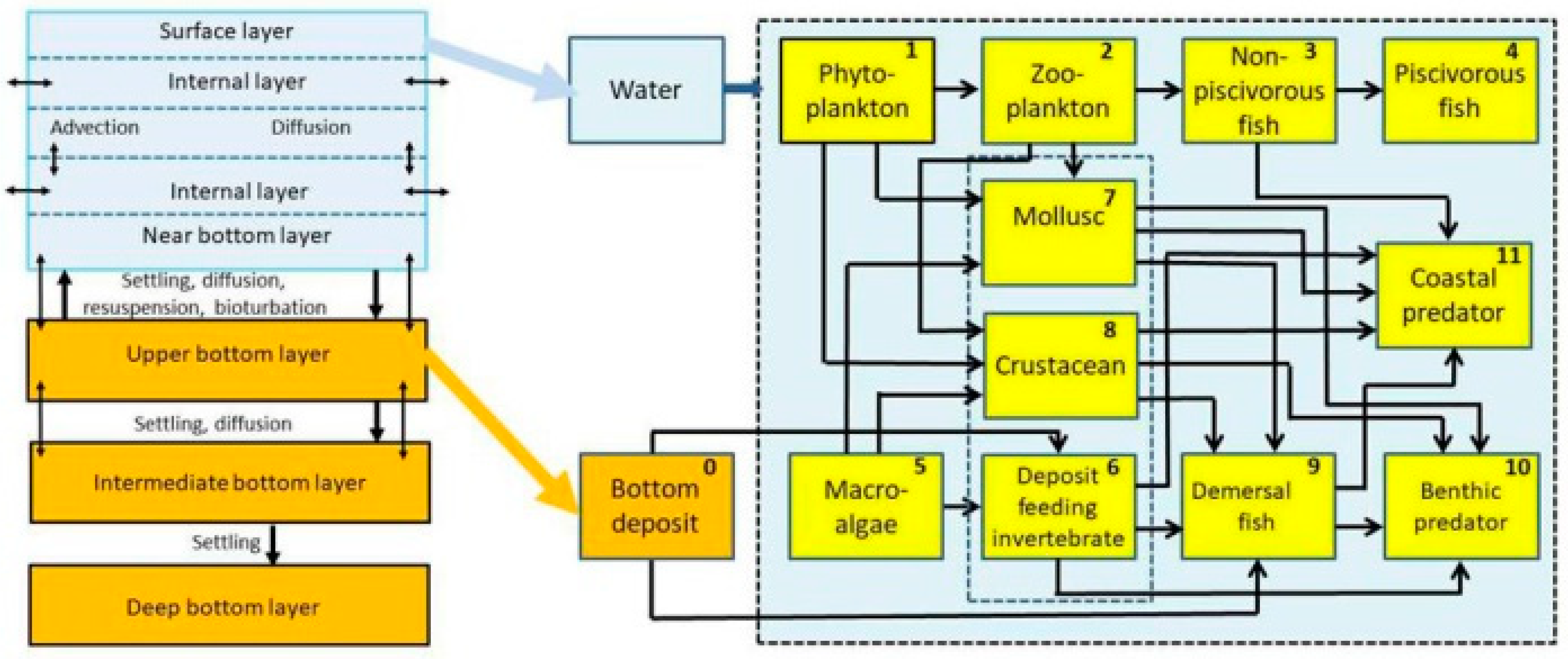
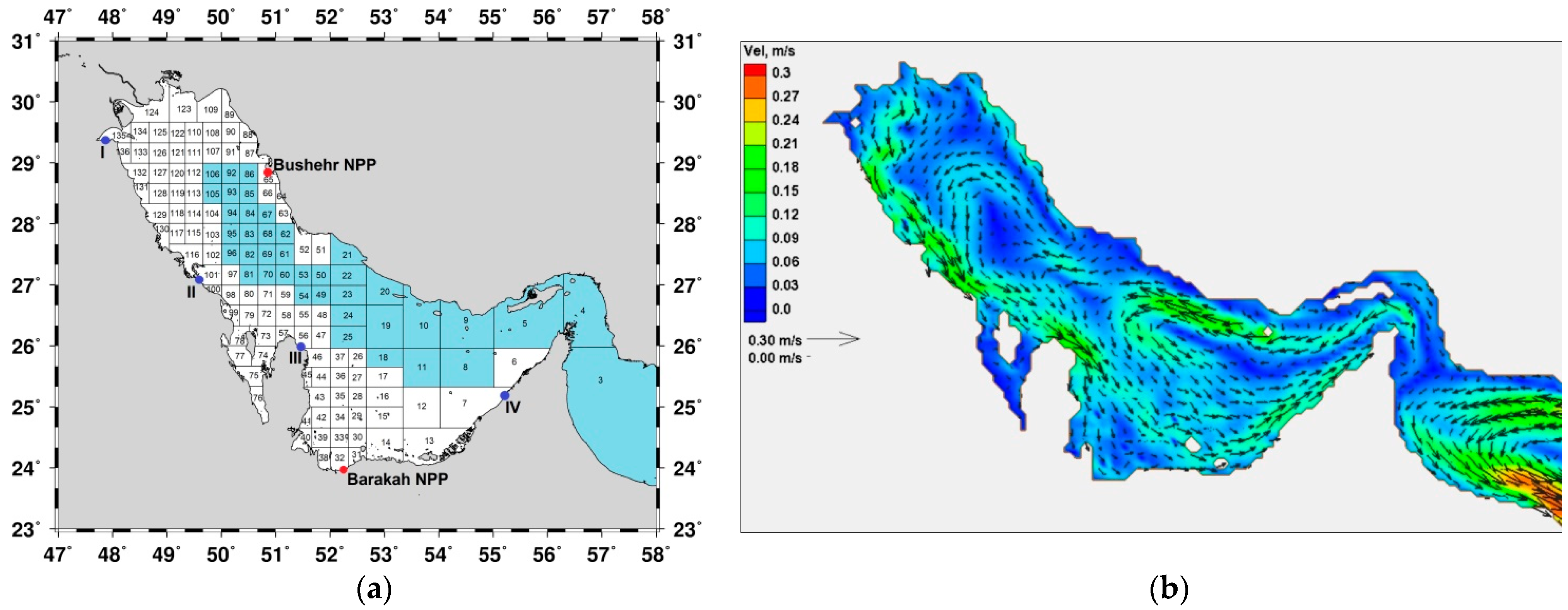
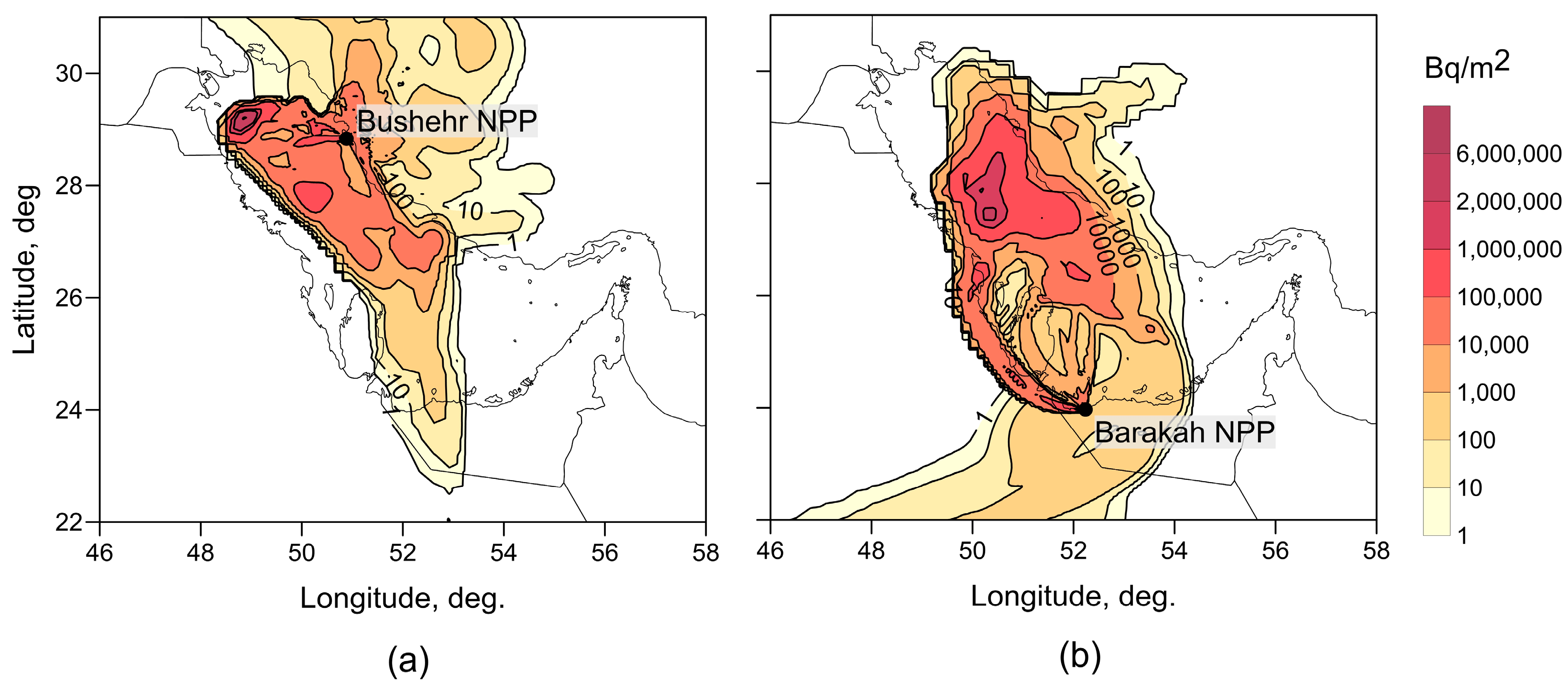
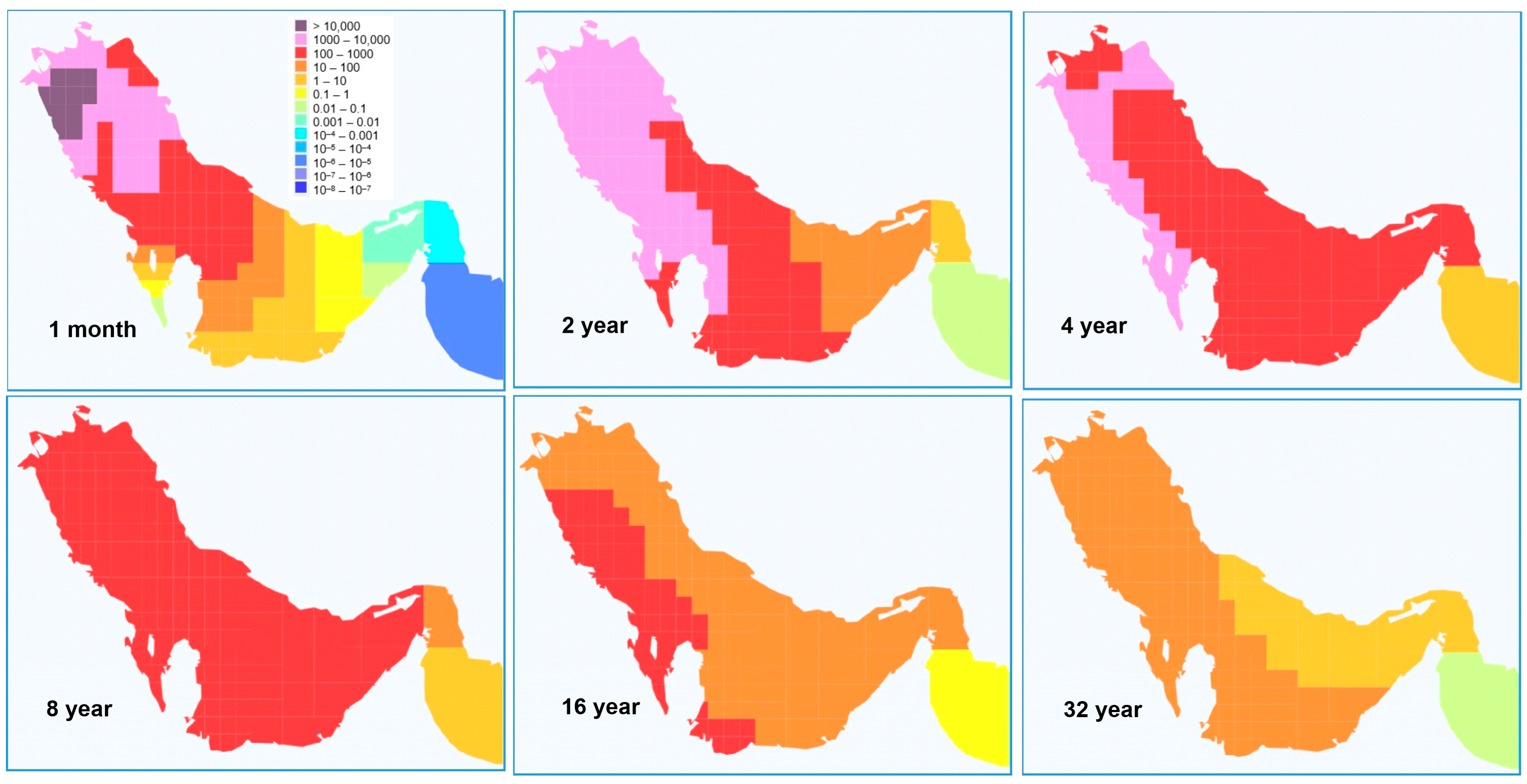
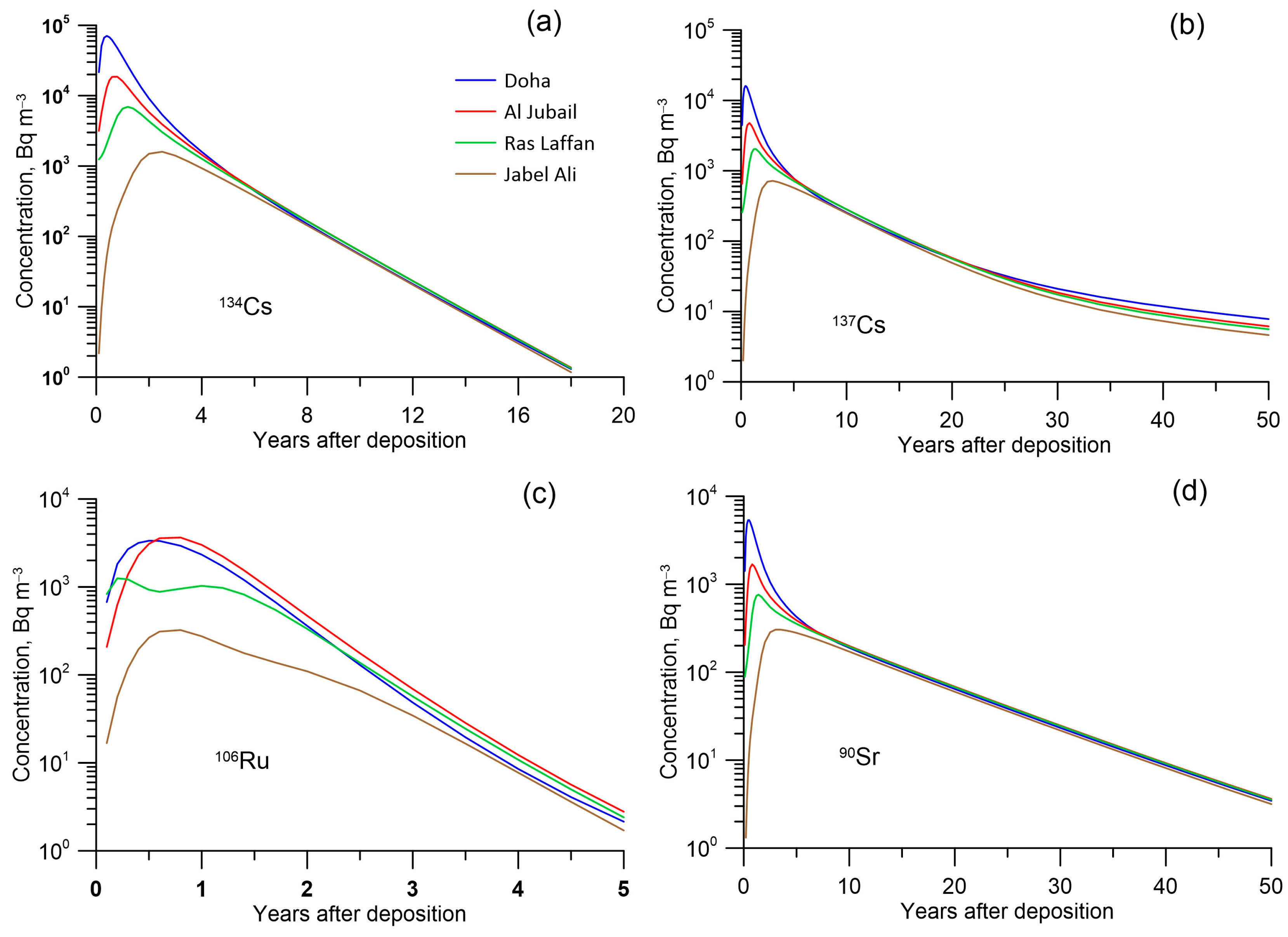
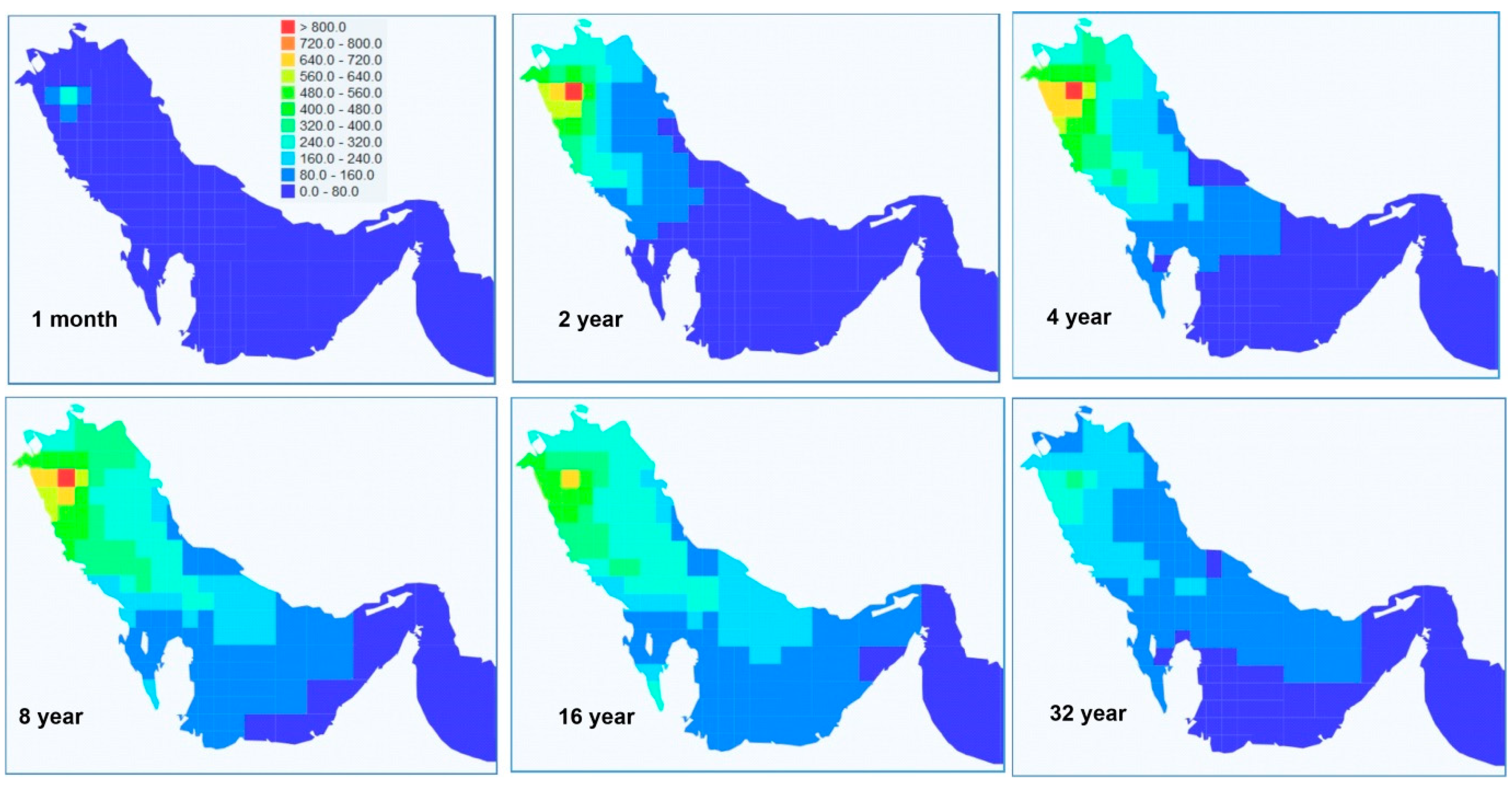
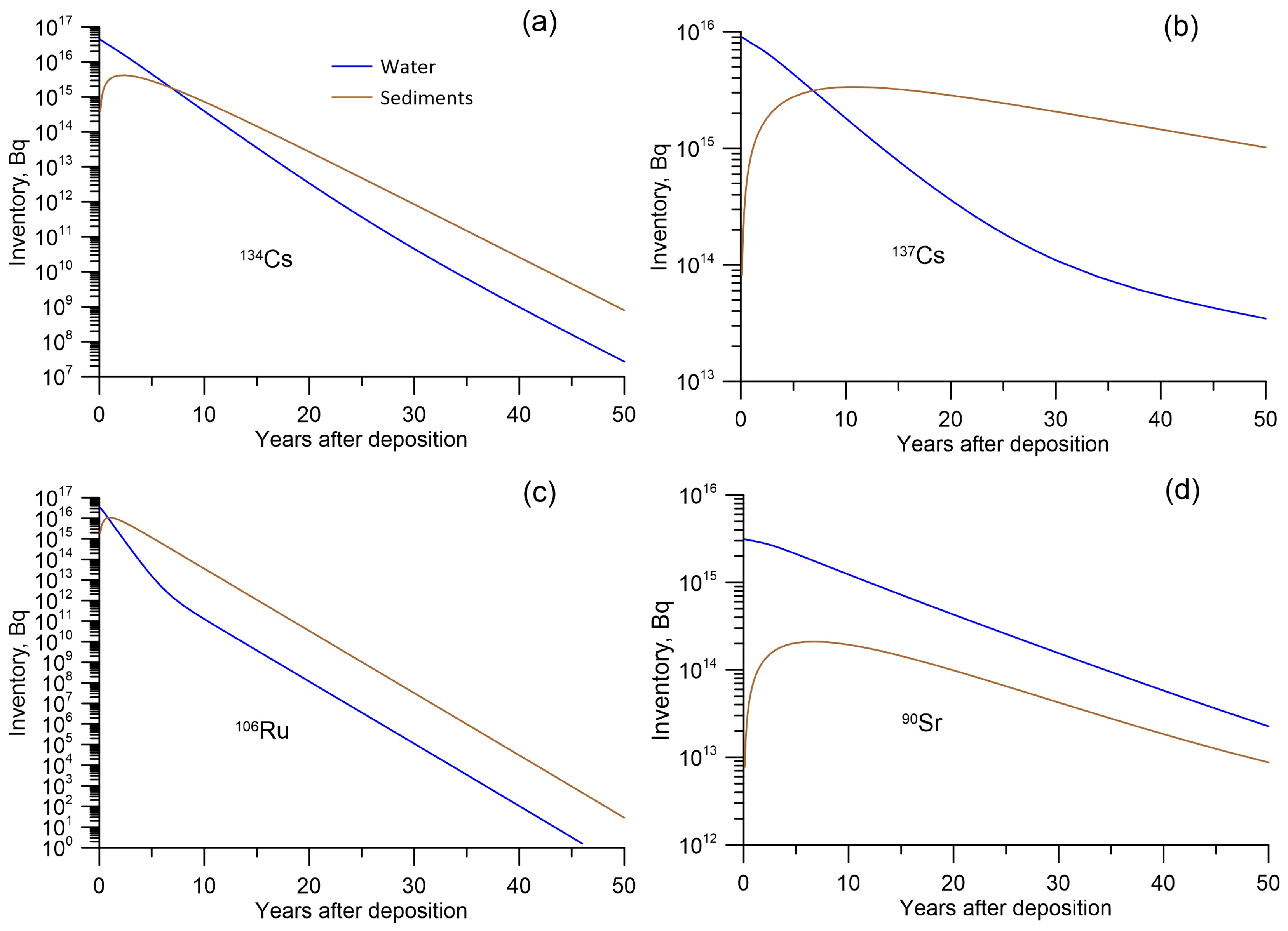
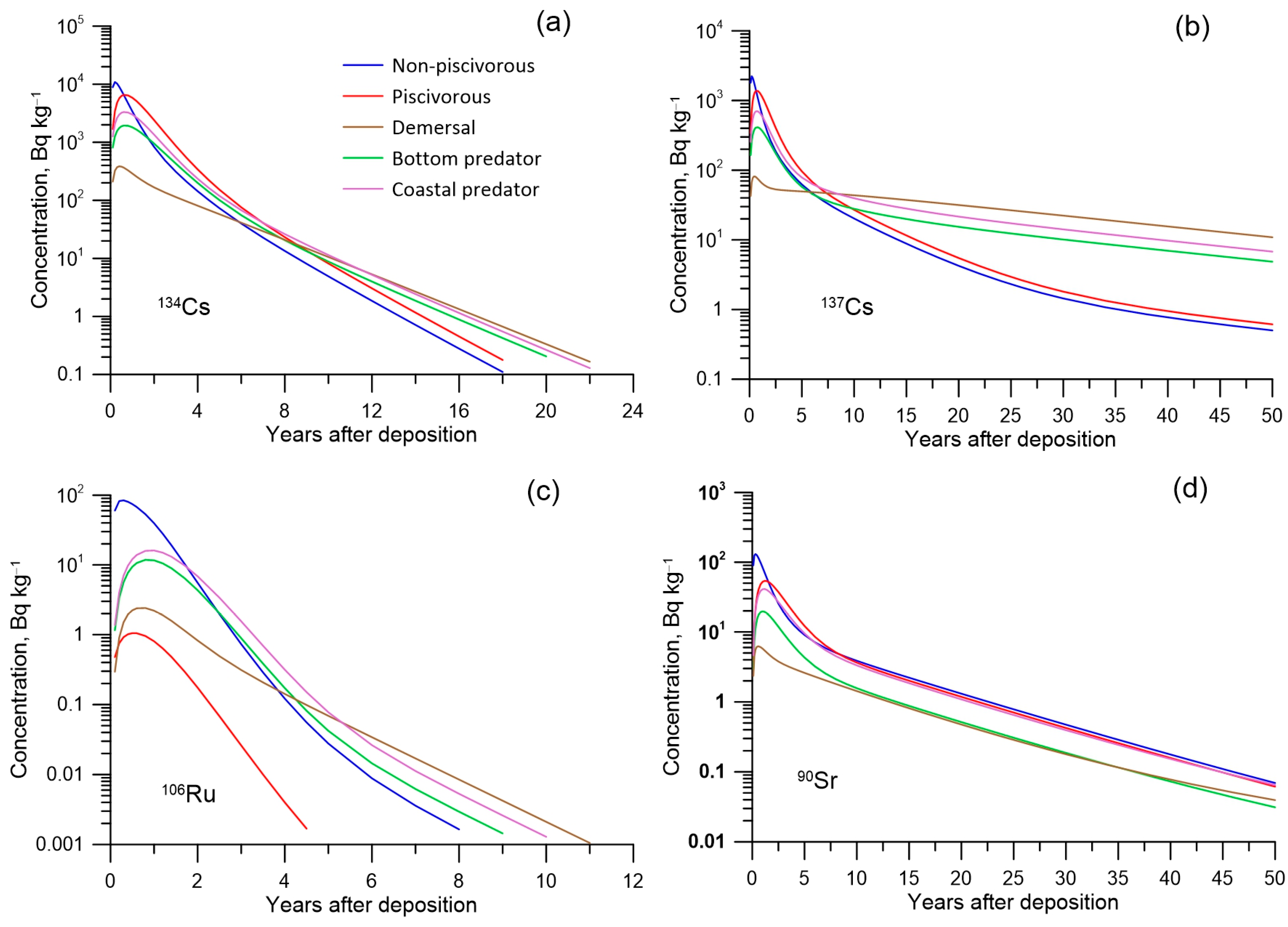
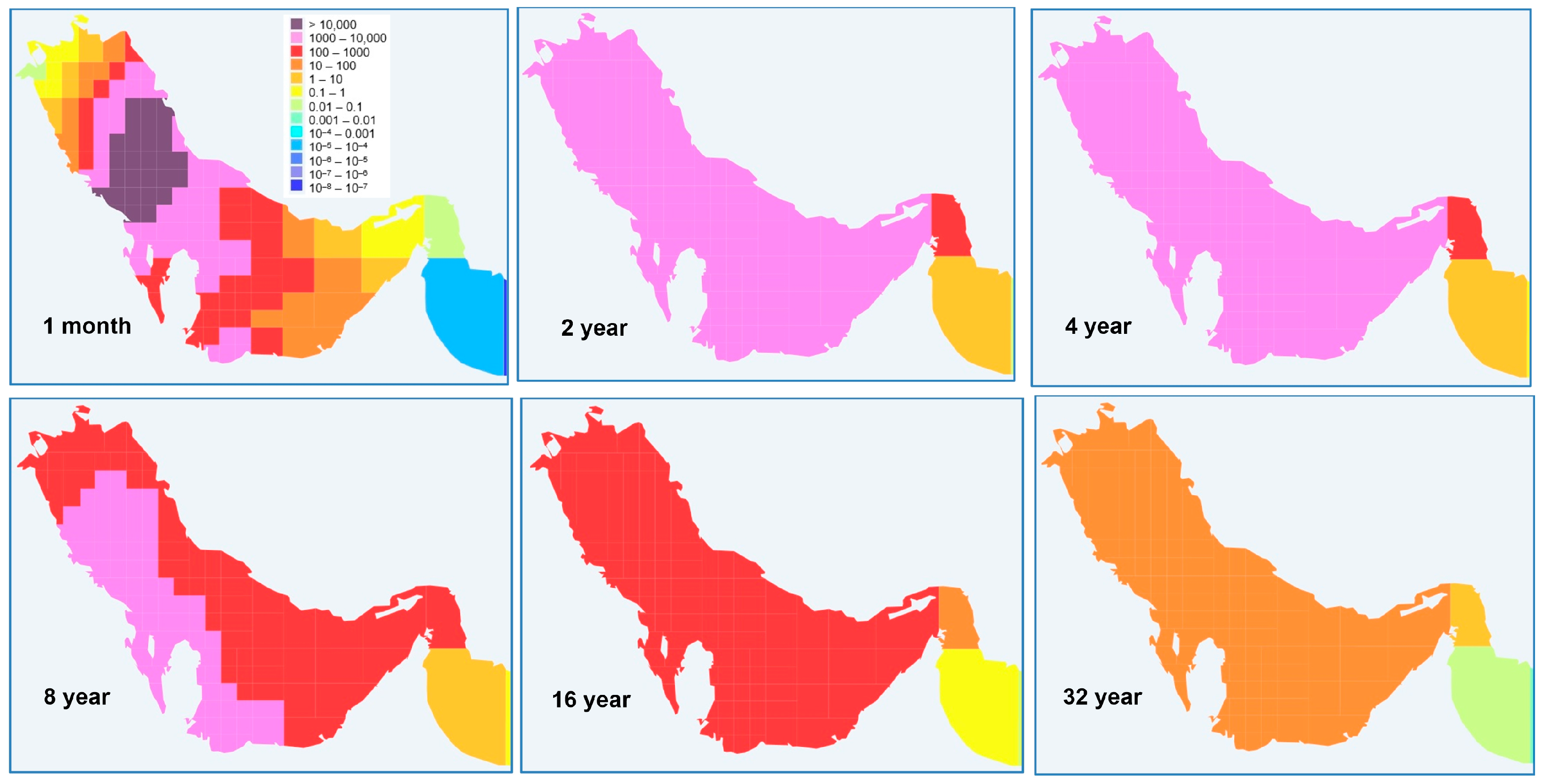
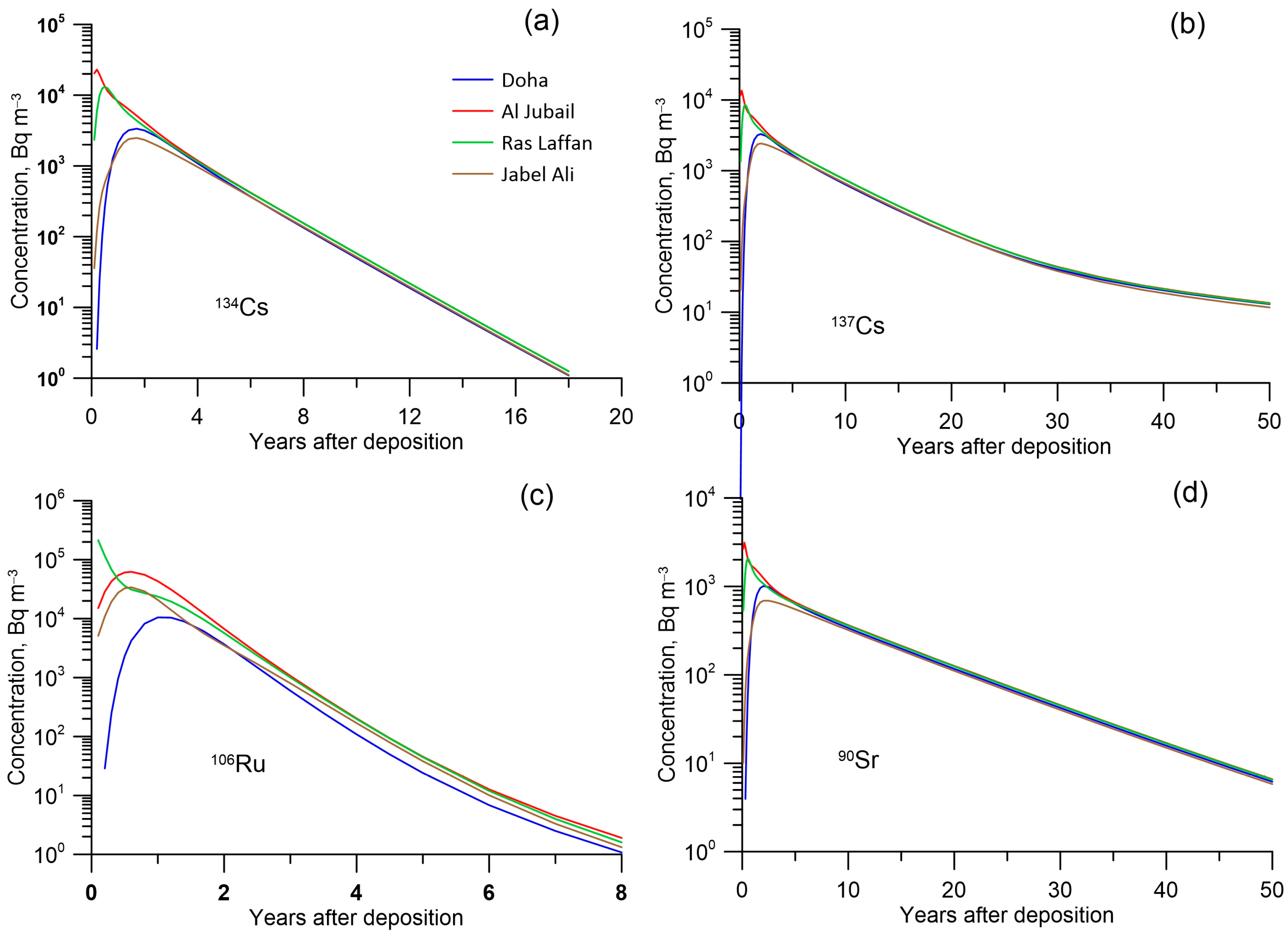
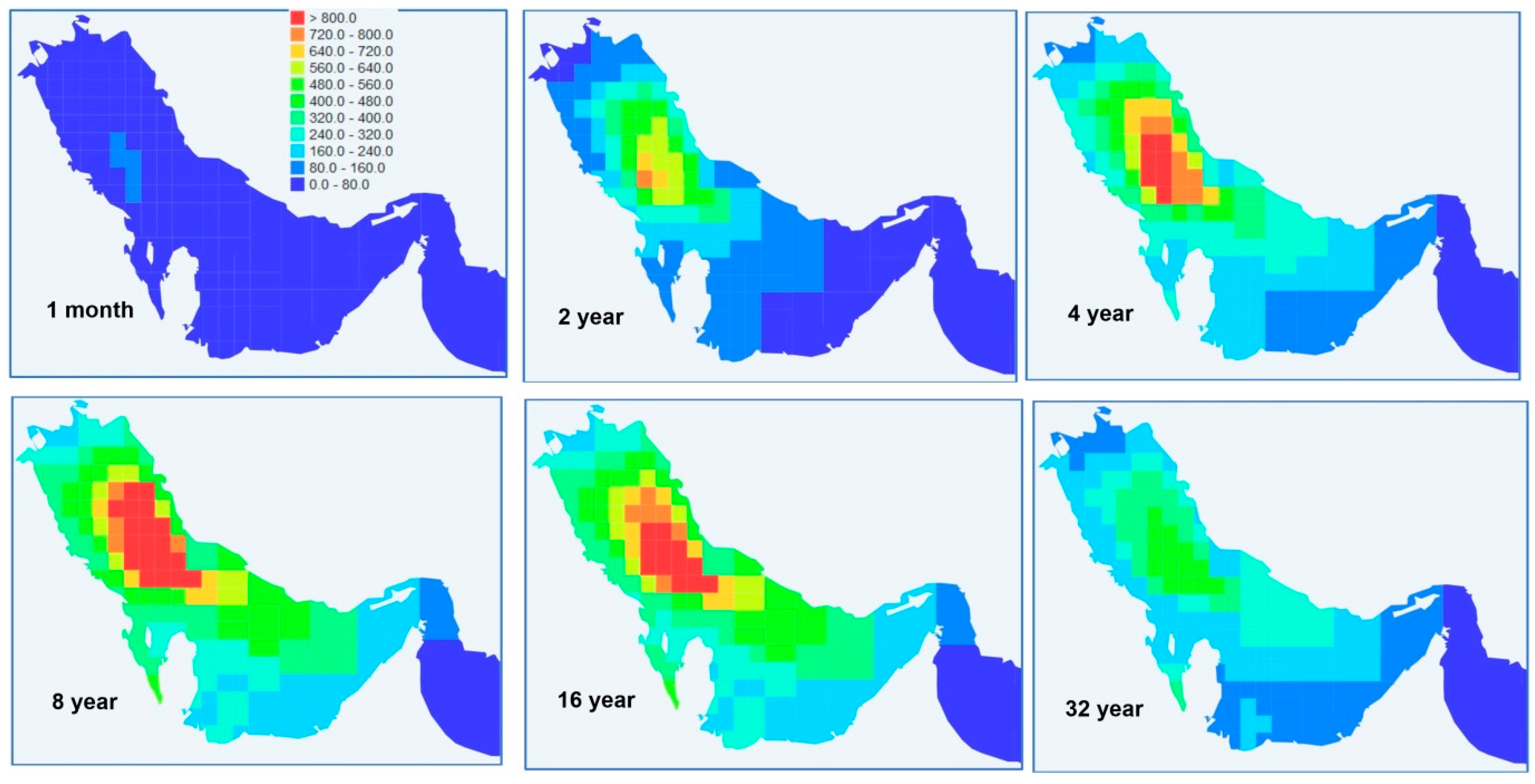
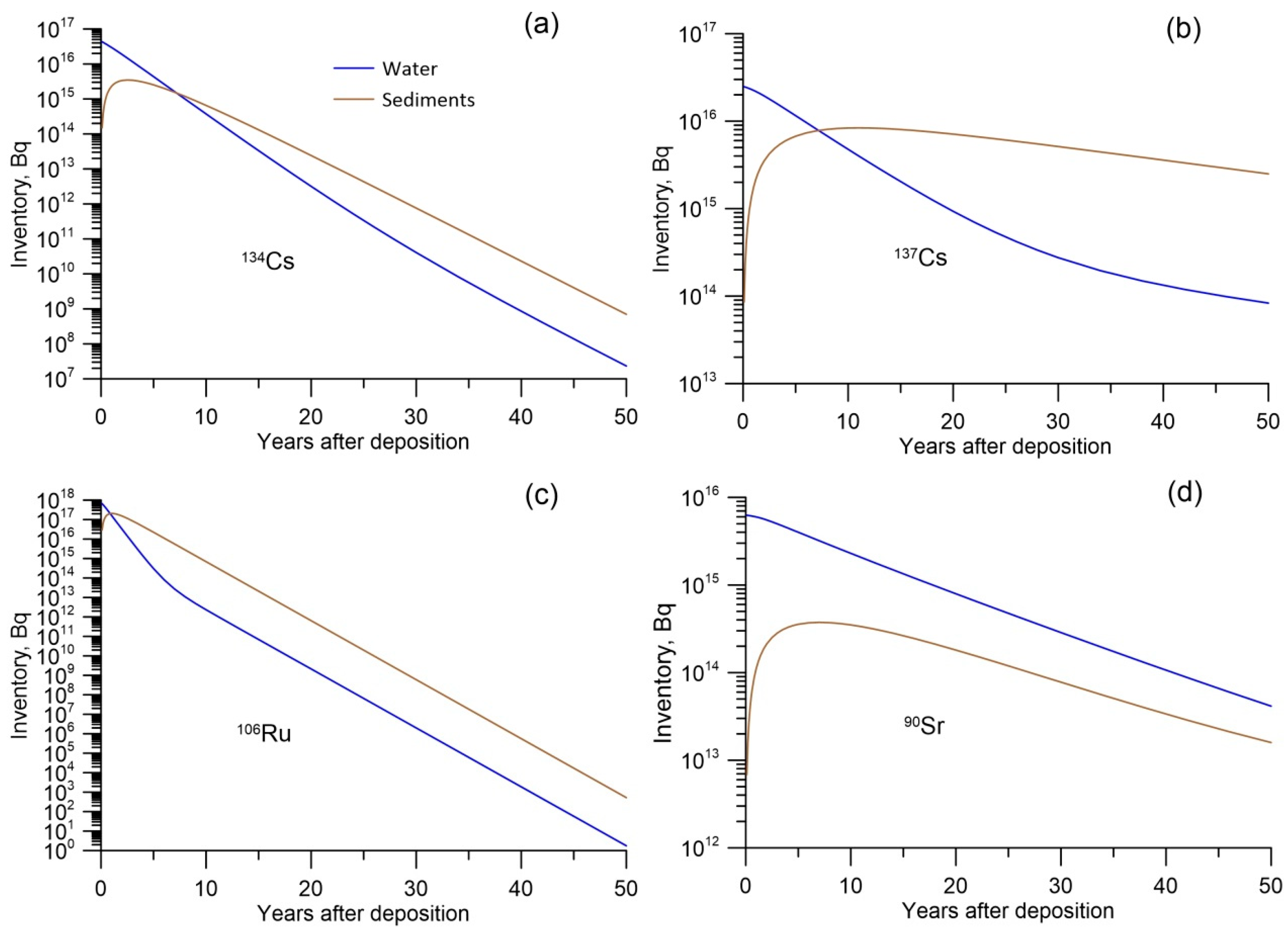
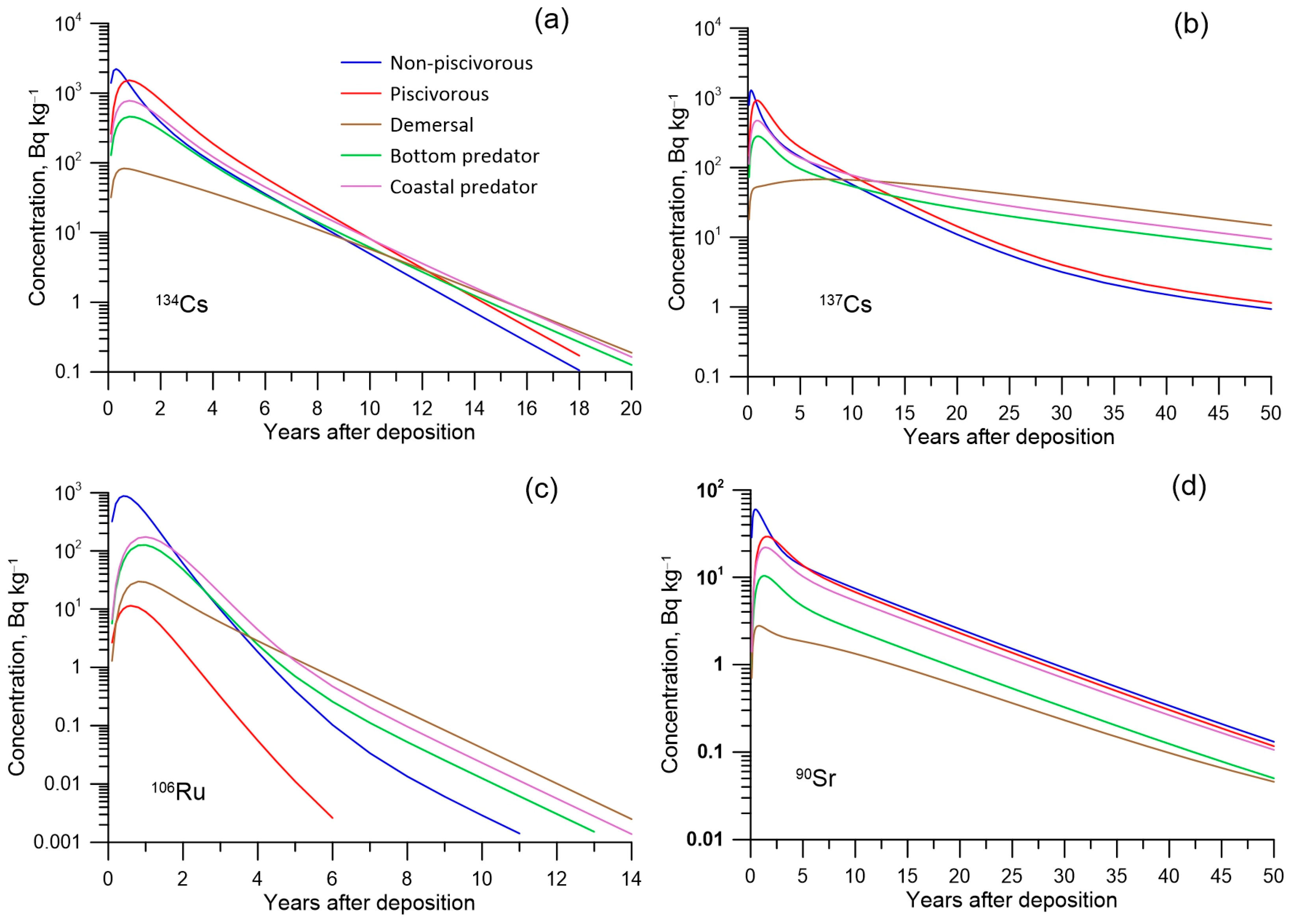


| Radionuclide | Released Fraction of Inventory, % | Released Inventory, Bq (Bushehr NPP) | Released Inventory, Bq (Barakah NPP) | % of Emission during First 3 h |
|---|---|---|---|---|
| 134Cs | 3.4 | 91 | ||
| 137Cs | 3.4 | 91 | ||
| 106Ru | 3 | |||
| 90Sr | 1.3 | 80 |
| Parameter | 134Cs, 137Cs | 90Sr | 106Ru |
|---|---|---|---|
| AEw | 1 × 10−3 | 3 × 10−5 | 8 × 10−6 |
| AEf | 0.76 1 | 0.29 2 | 0.006 2 |
| λwb, day−1 (prey types Nos. 3, 9) | 0.0092 | 0.0054 | 0.0164 |
| λwb, day−1 (predatory types Nos. 4, 10, 11) | 0.0046 | 0.0027 | 0.0082 |
| Radionuclide | Bushehr NPP | Barakah NPP | ||
|---|---|---|---|---|
| Dose, mSv | % | Dose, mSv | % | |
| 134Cs | 1.18 | 79.84 | 0.16 | 19.14 |
| 137Cs | 0.17 | 11.57 | 0.07 | 7.85 |
| 106Ru | 0.10 | 6.83 | 0.61 | 72.11 |
| 90Sr | 0.03 | 1.76 | 0.0075 | 0.90 |
| Organism | Bushehr NPP | Barakah NPP | ||
|---|---|---|---|---|
| Dose, mSv | % | Dose, mSv | % | |
| Non-piscivorous fish | 0.47 | 31.89 | 0.09 | 10.77 |
| Piscivorous fish | 0.35 | 23.89 | 0.06 | 6.94 |
| Demersal fish | 0.022 | 1.50 | 0.0039 | 0.47 |
| Bottom predatory fish | 0.11 | 7.57 | 0.034 | 2.33 |
| Coastal predators | 0.19 | 12.72 | 0.0196 | 3.87 |
| Crustaceans | 0.33 | 22.43 | 0.64 | 75.62 |
Disclaimer/Publisher’s Note: The statements, opinions and data contained in all publications are solely those of the individual author(s) and contributor(s) and not of MDPI and/or the editor(s). MDPI and/or the editor(s) disclaim responsibility for any injury to people or property resulting from any ideas, methods, instructions or products referred to in the content. |
© 2023 by the authors. Licensee MDPI, Basel, Switzerland. This article is an open access article distributed under the terms and conditions of the Creative Commons Attribution (CC BY) license (https://creativecommons.org/licenses/by/4.0/).
Share and Cite
Maderich, V.; Bezhenar, R.; Kovalets, I.; Khalchenkov, O.; Brovchenko, I. Long-Term Contamination of the Arabian Gulf as a Result of Hypothetical Nuclear Power Plant Accidents. J. Mar. Sci. Eng. 2023, 11, 331. https://doi.org/10.3390/jmse11020331
Maderich V, Bezhenar R, Kovalets I, Khalchenkov O, Brovchenko I. Long-Term Contamination of the Arabian Gulf as a Result of Hypothetical Nuclear Power Plant Accidents. Journal of Marine Science and Engineering. 2023; 11(2):331. https://doi.org/10.3390/jmse11020331
Chicago/Turabian StyleMaderich, Vladimir, Roman Bezhenar, Ivan Kovalets, Oleksandr Khalchenkov, and Igor Brovchenko. 2023. "Long-Term Contamination of the Arabian Gulf as a Result of Hypothetical Nuclear Power Plant Accidents" Journal of Marine Science and Engineering 11, no. 2: 331. https://doi.org/10.3390/jmse11020331
APA StyleMaderich, V., Bezhenar, R., Kovalets, I., Khalchenkov, O., & Brovchenko, I. (2023). Long-Term Contamination of the Arabian Gulf as a Result of Hypothetical Nuclear Power Plant Accidents. Journal of Marine Science and Engineering, 11(2), 331. https://doi.org/10.3390/jmse11020331






